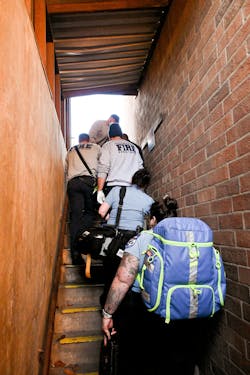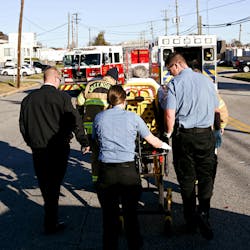Major tragedies of the past, such as the Great Chicago Fire and the 1906 San Francisco earthquake, led to the development of organizations to protect communities with fire suppression and rescue squads. The days of horse-drawn carriages with the bucket brigade led to the advancement of multifaceted fire science. The nod of acknowledgment goes to generations of firefighters who recognized patterns of fire and combustion of building materials and to the development of protective clothing and breathing equipment. In the same vein, members who trained as paramedics before becoming firefighters recognized the ability to be an asset in the face of emergency medical illness and injuries. Ultimately, those first-arriving fire company personnel were instrumental in interweaving firefighting skills and prehospital emergency medical care.
Multiple benefits
Formal training criteria at the state and federal levels have grown exponentially. Individual firefighters have increased their education and skills development, including EMS. The scope of blending these specialties can give the impression of a seamless fit. The essence of rescue as the initial removal from a fire building or at an MVA naturally morphed into rendering aid until the arrival of paramedics in an ambulance. Going back to the early 1970s, fire departments began to implement the dual-role firefighter/EMT and, thus, began the move away from single-role firefighters whose duties were to extinguish fires and to rescue people who were trapped in fire buildings. The dual-role firefighter/EMT—and firefighter/paramedic—engages in fire prevention, control and suppression and responds to emergencies where life, property or the environment is at risk.
The constructive concept of this practice seems to fit both the needs that are within the administration of departmental personnel as well as to enhance the safety and security of the public that’s served. Further, it’s a major socioeconomic response that embodies two employees for the price of one. Because of ever-increasing medical emergencies, the availability of an ambulance with paramedics often is stressed with multiple calls, which creates an increase in response times. Enter the dual-role firefighter/EMT, who provides fire suppression and rescue when dispatched to a fire scene and performs EMS when dispatched to the scene of a medical call, to assess a patient, to initiate care and to package the victim for the arriving ambulance. For the most part, this is a successful endeavor. Many lives have been saved.
The challenges
The “con” to the concept of the firefighter/EMT is that it can be difficult for these members to manage multiple responsibilities, including those that require intense physical activity (i.e., constant movement with split-second decisions to respond to the changes that come with heavy smoke, intense heat from billowing flames, and the combustion of various chemicals that develop from burning wood, furniture and other items that are contained within a home or business). For example, an engine company arrives at the scene of an active house fire where the billowing smoke is visible from blocks away. As a responding firefighter, there’s a conceptual preplan before arrival. The expectation and approach is a mental game, with the final moments before arrival dedicated to the course of action that’s needed to put out the fire. Depending on the assignment that’s given to the firefighter for the day—“You are on the pipe” or “You make the hydrant”—each role is defined and expected to be fulfilled.
However, consider this: Two adult females and one adult male, who all are more than 60 years old, are standing in the picture window and are oblivious to the fact that fire is in the back and involving their house. The cross-trained member has the wherewithal to go to the door and escort the people out of the fire building. This isn’t a slam to anyone; it simply shares an example of the importance of being able to focus on the task at hand.
As a general rule of thumb, firefighters are taught in the academy to follow their officer. Nevertheless, in the face of EMS calls, a modification of the rule is required, where the lieutenant or captain maintains an eye on the medical scene while the firefighter/EMT takes the proverbial “lead” with regard to patient care.
Additionally, the model of sending a fire engine or ladder truck to respond to medical emergencies has proven to be a major stressor on the vehicles. Furthermore, the continual barrage of large apparatus with lights and sirens has diminished the recognition of urgency by the public, to which many of us can attest by the lack of respect from citizen drivers. The rules of the road have changed from “pull to the right” to just “stop in place,” which causes more delays than are documented.
Finally, improvements must be made regarding the time that passes from when a citizen calls for a nonemergency service to the dispatch of an emergency vehicle. The development of steering committees that utilize the boots-on-the-ground firefighters as guidance (instead of a political fix) is one way to start the process.
One must remember that the concept of most good ideas inevitably can morph into the potential for abuse of the system. The utilization of firefighters as human muscle that’s expected to simply assist citizens becomes an expectation that creates additional stressors with response times and staffing.
This might not seem like a big deal, given that the dual-role firefighter/EMT has become the “norm,” but the effect is more than the combined development of skills that are needed to fight fires and to assist with medical emergencies.
The bottom line
The scope of practice to become an EMT includes an ever-growing curriculum that reflects the expansion of intricate details that are related to evaluation, treatment and transport. Technology and the advancement in prehospital EMS that has increased the equipment on ambulances, engines and trucks have contributed to saving lives. For instance, cross-training for members of a first-responding fire company has been instrumental in the implementation of cardiac care. Major training organizations support the importance of recognizing cardiac arrest and beginning chest compressions with hands-on CPR to sustain patients until the arrival of a cardiac monitor.
Technology and the advancement in prehospital EMS also saves livelihoods. The initiation of cross-trained firefighter/EMTs contributes to saving the life of firefighters at the scene of emergencies and at incidents at the firehouse.
Cross-trained firefighter/EMTs bring a sense of relief to citizens when those members arrive with more than just equipment to suppress fire. These members bring the confirmation that everything that can be done to help to save a life will be put into action.
About the Author

Maggie Coen-Murphy
Maggie Coen-Murphy retired as an ambulance commander of the Chicago Fire Department (CFD) after serving more than 30 years. She graduated from the Chicago Citywide Colleges Paramedic Program and later earned her bachelor’s degree from the University of Phoenix. Coen-Murphy currently serves as a Silver Spanner paramedic and EMS education coordinator for the UChicago-Ingalls Paramedic Program. She is a committee member of the CFD Retiree Memorial organization.

